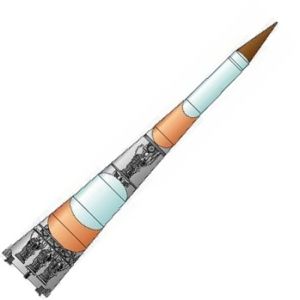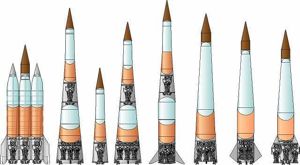
Home - Search - Browse - Alphabetic Index: 0- 1- 2- 3- 4- 5- 6- 7- 8- 9
A- B- C- D- E- F- G- H- I- J- K- L- M- N- O- P- Q- R- S- T- U- V- W- X- Y- Z
G-2
 Groettrup G-2 |
AKA: R-12;R-6. Status: Study 1948. Payload: 1,000 kg (2,200 lb). Thrust: 1,000.00 kN (224,800 lbf). Gross mass: 50,000 kg (110,000 lb). Height: 24.50 m (80.30 ft). Diameter: 3.70 m (12.10 ft).
More than ten G-2/R-12 variants were studied in detail to determine the optimum technical solution. All used a common bulkhead between the aft fuel and forward liquid oxygen tank. Two major aerodynamic forms were considered - conical, which was aerodynamic stable regardless of the stage velocity and vehicle center of gravity, and cylindrical stages with fins. The variants studied were as follows:
- G-1 cluster - two G-1's as the first stage flanking a single G-1 as the second stage. Lift-off mass 50 metric tons, lift-off thrust 100 metric tons, total span 6 m, length 15 m.
- R-12A dual sequential stage. Conical form, with 3 G-1 engines in the first stage and a single G-1 engine in the second stage. Length 25.3 m, diameter at the base 4.0 m.
- R-12B short-range V-2 replacement based on second stage of R-12A. 2.4 m base diameter, 16.0 m long.
- R-12C dual stage. A variation of the R-12A with a larger-diameter upper stage. 19.2 m long.
- R-12E dual stage. Cylindrical first stage with aerodynamic stabilizing fins
- R-12G single stage design with conical form
- R-12H single stage with cylindrical form and aerodynamic stabilizing fins
- R-12K with jettisonable booster engines.
The optimum technical solution seemed to be the R-12G single-stage conical design. In comparing the G-2 with Korolev's R-2, the state commission favored the Groettrup design. But the Russian designers convinced the government that the G-2 required innovations beyond the immediate capability of Soviet technology. Korolev's R-2, a modest upgrade of the V-2, was selected for production instead.
Maximum range: 2,500 km (1,500 mi).
Family: IRBM. Country: Russia. Agency: Groettrup Design Bureau. Bibliography: 394, 476, 86.
1946 September - . LV Family: Groettrup. Launch Vehicle: G-2.
- Groettrup team designs 2 stage IRBM. - . Nation: Russia. Related Persons: Groettrup. Groettrup sketches design for a 2500 km range missile..
1949 March - . LV Family: Groettrup. Launch Vehicle: G-2.
- Groettrup team completes G-2 design. - . Nation: Russia. Related Persons: Groettrup. Groettrup completes design work on G-2, 1,000 kg warhead, 2500 km range..
Back to top of page
Home - Search - Browse - Alphabetic Index: 0- 1- 2- 3- 4- 5- 6- 7- 8- 9
A- B- C- D- E- F- G- H- I- J- K- L- M- N- O- P- Q- R- S- T- U- V- W- X- Y- Z
© 1997-2019 Mark Wade - Contact
© / Conditions for Use
